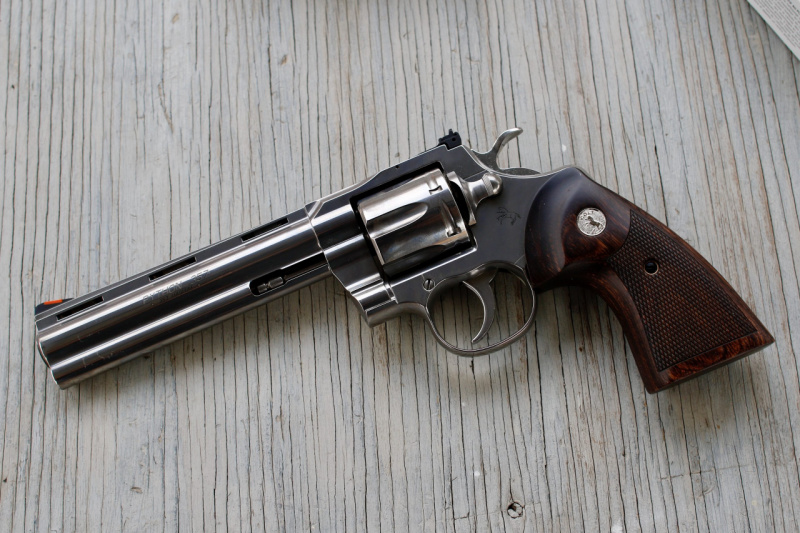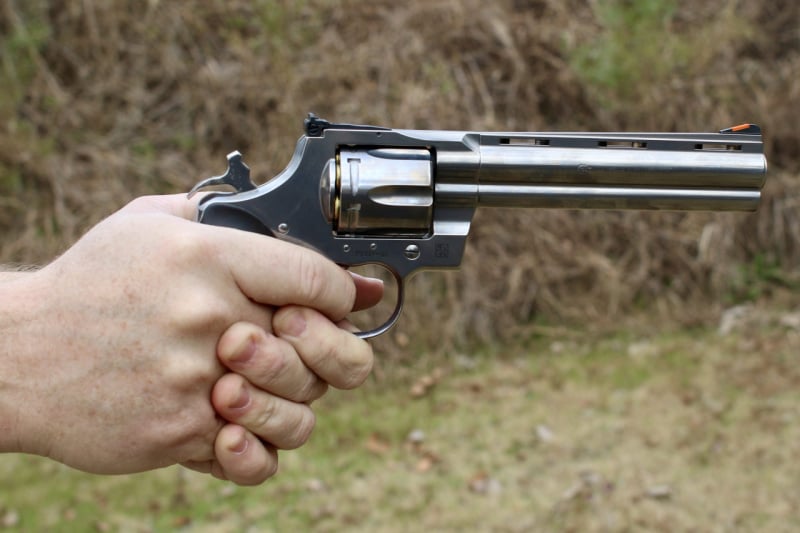If you Google Colt Python, a pretty good question comes up: “What’s so special about the Colt Python?”
That’s not easy to answer. And I’d be willing to bet the answer will change for each person answering it. For most, it is nostalgia. Some like the distinct look. For others, it is a .38 that weighs as much as some compact cars.

Now that the Colt Python is back in production, though, one of the previous answers is somewhat moot: scarcity. When the Python was discontinued, the prices went through the roof. The Colt Python became a collector’s item the way art does when the artist kicks off.

I once paid $2,500+ for a 6″ blued Python from the 70s. The gun was in pristine condition. It shot like a champ, too. Yet every time I pulled the trigger, I’d wince. I knew the value decreased each time a piece of lead ripped down the barrel.
I didn’t own it long. It was burning me up that I couldn’t shoot it like I wanted. Money was tight, and I couldn’t afford to strip that snake of its value, so I moved it on to a new home. A better home.
It now lives in a safe and only comes out once or twice a year for a new coat of oil. As for the money I made selling it—I’ve pissed it away on something I can’t remember. No more money, no more old Python. What was I thinking?

What is so special about the Colt Python?
I’d like to say that there’s a magic to the size and shape, but you can get similarly sized guns from Dan Wesson and from Smith & Wesson. I’ve run those, too, and they compare favorably. I’d happily pick up any one of those and a box of .357s and be thrilled.
I’m a dedicated S & W 686 fan, too. I can wax poetic about its virtues for hours on end. But it has always felt like a new gun and not a living piece of history, which is how I’ve come to think of the Python. So for me, the answer must be nostalgia.

Colt Python Specifications:
- Barrel: 1:14 LH, 6 Groove
- Barrel Length: 6 inches
- Capacity: 6 rounds
- Finish: Semi-Bright
- Frame Material: Stainless Steel
- Grips: Walnut Target Stocks
- Height: 5.5 inches
- Width: 1.55 inches
- Overall Length: 11.5 inches
- Weight: 46 ounces
The build quality, though, is fantastic on the Python. The fit and finish are, for a production revolver, astounding. I’ve seen guns from Korth and from Cabot that cost significantly more that have better finishes, but that’s hardly an apples-to-apples comparison. Colt and Smith built the market for large-frame double-action revolvers, and they still dominate the game.

As such, it may seem completely contradictory that Colt killed off the Python, and some of the other snakes, over a period of years. The announcement came in late 1999, but the last of the Pythons rolled out of the Custom Shop as late as 2005. Those were dark years for those of us who had fond memories of the old behemoths. And dark years for those who’d missed out on the chance to pick up a clean Python as an investment.

All told, the original Pythons were in production for nearly half a century. Then there was a 20-year hiatus, and now it is back. These new Pythons are very similar to the originals.

The New Pythons
The Python has adjustable sights. The front blade is replaceable. The rear sight adjusts for windage and elevation.

The Python has a Kickass trigger, too. This one’s double-action pull measured at 8 pounds. The single-action pull is crisp.
The weight is also something Colt refuses to compromise. Pythons have full lugs under the barrels. Extra mass from that lug and the ventilated rib on top add stability and cut down muzzle flip.

Most importantly, the lock-up was tight. The Python’s cylinder gap is minuscule. This has long been one of the competitive selling points of this platform. Die-hard fans claim that the lock-up is tighter on the Pythons than on any other production model revolvers. I don’t have a wide enough selection of guns, much less the tools, to measure this claim, but the Python’s fit is really impressive.

The walnut grips are made by Altamont. When I hear Altamont, I think of the disastrous Stones concert in 1969, but Altamont is an accessory company with a long history in this industry. They began cutting ivory grips for Colt back in the 1980s, back when ivory was still legal in the states, and they have been building gun grips ever since.
Shooting the Snake
I’ve been shooting large-frame .38s for a solid decade now, and I can run them proficiently in both double and single-action. I can run them decently fast. And, when it comes to accuracy, the Python excels. It shoots straight.

The trigger is fantastic. Its break is clean. The fall of the double-action pull is easy to predict and hold, if needed, for the ideal alignment of sights. In single-action mode, the Python performs exactly how you’d think a Python would.

Early production problems
This is the only place where I will say anything about the Python that won’t make me sound like a bootlicking sycophantic shill. I did have a problem with sustained sequences in double action mode. When shooting all-out, dumping six shots onto a steel target as one might in a defensive shooting situation, I had a misfire.
That click only happened when I was pushing the gun to its limit. I’d stop, pull the trigger normally, and the next round would fire. Turns out, I think the side plate screws were loose. Colt reported this a problem themselves, so I wasn’t the only one seeing it.
Essentially, the hand that turns the ratchet on the cylinder is supported by the side plate. As the trigger is pulled, the hand travels up. When I was pushing the gun, the hand would skip out of the ratchet gear, so the cylinder didn’t turn. The hammer then fell on an empty shell.
I’m reporting it more out of a concern for awareness for anyone thinking of picking up a used Python. Colt has addressed this issue, so the new production models should be good to go.
Even with that hitch in its giddy-up, I’m still a fan. The Colt Python has always felt like a serious chunk of steel in the hand—like a gun should feel. And this problem is easy to fix with a bit of torque once you recognize what it is. Once the side plate is tightened down, the hand functioned properly.

Extras
As far as accessories go, you may want a speed loader. These are as close as you can get to a mag-change with revolvers. A six-shot version will work. There are speed strips, too, that allow you to keep rounds organized and ready.
Otherwise, all you’ll need is a holster. The Colt snakes are all classified by their barrel lengths. Check out the legacy brands, like Bianchi, for holsters that are on par with the investment you’ll be making in the gun. The Bianchi Model 111 or 5BHL are both solid contenders and will outlast you, if you take care of them.
A solid investment?
MSRP on the Python is $1499. The 6″, 4.25″, and 3″ Python are all the same price. As of this writing, they’re only available in stainless.
Is this a solid investment? I don’t see why not. Demand remains high. Supply remains on the low side. And they may not be around forever.



Pingback: CZ 457 Scout 22 LR: An Heirloom Quality Training Rifle - The Mag Life()